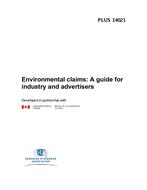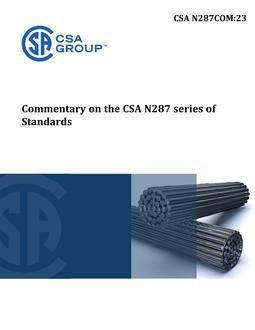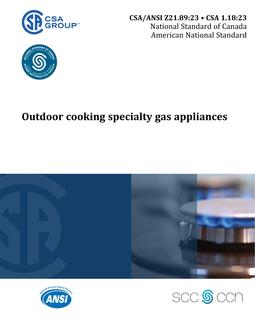
CSA PLUS 14021 (2nd ed. pub 2008)
- Comments Off on CSA PLUS 14021 (2nd ed. pub 2008)
- CSA
Click here to purchase
Preface
This is the second edition of CSA Special Publication PLUS 14021, Environmental claims: A guide for industry and advertisers. It supersedes the previous edition published in 2000, entitled The CAN/CSA-ISO 14021 Essentials. The first objective of this Guide is to provide the users of ISO 14021, Environmental labels and declarations – Self-declared environmental claims (Type II environmental labelling), with a best practice guide to the application of the standard and some practical examples of how the standard could be applied to environmental claims in the Canadian marketplace.
1 Introduction
1.1 General
Canadian consumers are becoming increasingly concerned about the environmental performance of products. For example, consumers are concerned about the resources and energy used to produce products, and about the sustainability of the product design (can it be reused or recycled? is it biodegradable? is it made of recycled materials?) among other issues. This has led to an increased demand for environmental information about products from consumers, government, and industry. Industries may choose to communicate environmental benefits through environmental labelling and use advertising vehicles to promote these benefits. There are a wide range of descriptors, logos, vignettes, and other representations used to describe or imply environmental claims for consumer products. This means of communicating environmental claims is often called “”green marketing””.
Environmental claims allow consumers to more easily differentiate between products in the market, so consumers can make better purchasing decisions in relation to the environment. In turn, consumers’ purchasing power for such products is a market driver for business to invest in more sustainable environmental practices. Environmental claims, declarations, eco-logos, and other eco-labels have a number of characteristics that allow the receiver to distinguish one kind from another. Eco-labels may be
– self-managed or third-party-managed;
– verified in-house or independently verified and/or certified;
– based on the product life cycle or a single attribute;
– available for single or multiple sectors – product categories; and
– designed to demonstrate environmental leadership, relative performance, or just provide information.
The value of environmental claims rests on the assurance that the information provided is credible, objective, and easily identifiable and understood by consumers. Standards play an important role in providing guidance to ensure responsible claims in industry and advertising.
Standards for environmental claims benefit consumers, industry, and advertisers by providing a level playing field and consistency in terms and application. They also provide continual improvement through the maintenance of a standards program that is updated as environmental practices and scientific information evolve. The ISO 14020 Series of Standards on environmental labels and declarations has been developed to help in this regard. This series comprises Type 1 eco-logo labels (CAN/CSA-ISO 14024), Type II self-declared environmental claims (CAN/CSAISO 14021), and Type III environmental profile declarations (CAN/CSA-ISO 14025). Those making claims of conformity with the standards for all three types of labels are required to consider the impact of the life cycle of the product or service on the environment and be able to
support the claim with verifiable data.
Type I eco-logo labels, which are independently verified by a third party through a testing process at the request of the manufacturer of the product, give consumers an indication of the environmental preferability of a product (or service) within a product category based on product life cycle considerations (environmental performance according to predefined criteria and/or a set of environmental attributes, e.g., “”best 20% in class””). Examples of certification labelling programs include Canada’s “”Environmental Choice”” program where the eco-logo symbol is awarded to top performers: since 1998, over 2000 products and services have met or exceeded the standards of this program. The eco-logo indicates that a product will, for example, improve energy efficiency, reduce hazardous waste by-products, and make use of recycled materials. The Energy Star logo is another type of eco-logo, which is awarded to top products based on energy efficiency (e.g., energy-efficient appliances, equipment, windows, and doors). The consumer should keep in mind that eco-labelling programs or schemes do not assess the whole range of products available in the marketplace; there could be equally “”green”” products that have not been tested or certified.
Type II self-declared environmental claims, which are the focus of this Guide, are the kind of claims that are made by manufacturers, importers, distributors, or any person who promotes a product/service or business interest who is likely to benefit from the product’s environmental claims. These claims are usually based on a single attribute (e.g., a manufacturer’s claim that a product is “”biodegradable””) without taking into account the environmental impact of a product’s entire life cycle, and without independent verification or certification by a third party. However, these claims must be verifiable, accurate, meaningful, and reliable if consumers are to understand the value of the environmental information they represent (e.g., their ability to protect the environment). The credibility of these claims can be increased if companies and organizations are able to support their claims by providing reliable information to purchasers or potential purchasers seeking to make more informed purchasing decisions on products or services. Consumer expectation can be raised by such claims, given the heightened public interest and awareness in the environment. These types of claims can also be made on a product that displays an eco-logo or Type 1 label.
As this Guide is based on CAN/CSA-ISO 14021, it is worth recalling that it is concerned only with self-declared environmental claims (Type II). This is not to say that other types of environmental claims are not important or do not fall under the laws administered by the Competition Bureau, but their application is outside of the intended scope of this Guide.
Type III environmental data declarations are comprehensive data lists that profile environmental information on a product throughout its life cycle; their level of detail is similar to that provided on nutrition labels on food. As these claims require disclosure of comprehensive data relating to environmental performance, the consumer might not always have the ability to assess such claims in terms of identifying and weighing the environmental risks related to a product or service.
Other labelling standards form part of the CAN/CSA-ISO labelling series. For summaries of these see Annex A of this Guide. ISO 14021, Environmental labels and declarations – Self-declared environmental claims (Type II environmental labelling) was published in 1999. This Standard was reaffirmed in 2004 and is scheduled to be reviewed for the next standards development cycle for a new edition in 2008.
ISO 14021 has been translated into several languages in addition to the official languages of ISO (English, French, and Russian) and is widely used as a voluntary and regulated standard. In 2000, ISO 14021 was adopted by the Canadian Standards Association (CSA) as CAN/CSA-ISO 14021.
Product Details
- Edition:
- 2nd
- Published:
- 06/01/2008
- ISBN(s):
- 9781554367702
- Number of Pages:
- 75
- File Size:
- 1 file , 570 KB



